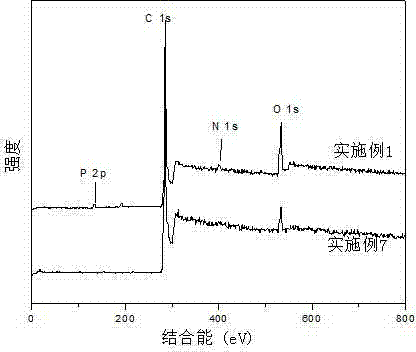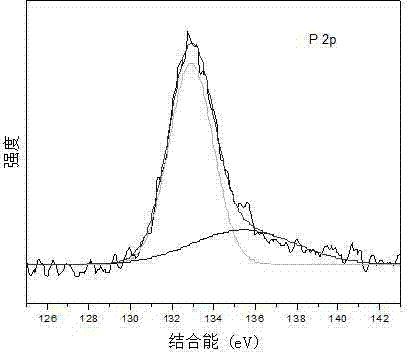Preparation method and application of nitrogen and phosphorus codoped carbon oxygen reduction catalyst for microbial fuel cell
A fuel cell and co-doping technology, applied in the direction of electrical components, battery electrodes, circuits, etc., to achieve the effects of simple preparation process, increased output power, and easy expansion
- Summary
- Abstract
- Description
- Claims
- Application Information
AI Technical Summary
Problems solved by technology
Method used
Image
Examples
Embodiment 1
[0026] Step 1: Catalyst Preparation
[0027] Soak 10 g of microcrystalline cellulose in 100 mL of 1 M (NH 4 ) 3 PO 4 The solution was stirred for 24 h and then filtered with suction. The filter cake was dried in an oven at 80 °C. After it was taken out and ground evenly, it was put into a porcelain boat and placed in a quartz tube in a tube furnace. Under the protection of high-purity nitrogen with a flow rate of 100 mL / min, the tube furnace was heated to 900 °C, kept at a constant temperature for 1 h, and cooled naturally. , to obtain black powder. After washing with distilled water for 3 times, dry it to obtain the catalyst.
[0028] Step 2: Fabrication of air cathode and electrochemical performance test
[0029] Ultrasonically disperse conductive carbon black in ethanol, and dropwise add PTFE emulsion equivalent to 7 / 3 mass of conductive carbon black. Continue to exceed
[0030] Squeeze and stir until an elastic, dough-like mass forms. Take it out and roll it into ...
Embodiment 2
[0035] Step 1: Catalyst Preparation
[0036] Soak 10 g of microcrystalline cellulose in 100 mL of 1 M (NH 4 ) 3 PO 4 The solution was stirred for 24 h and then filtered with suction. The filter cake was dried in an oven at 80 °C. After it was taken out and ground evenly, it was put into a porcelain boat and placed in a quartz tube in a tube furnace. Under the protection of high-purity nitrogen with a flow rate of 100 mL / min, the tube furnace was heated to 1000 °C, kept at a constant temperature for 1 h, and cooled naturally. , to obtain black powder. After washing with distilled water for 3 times, dry it to obtain the catalyst.
[0037] Step 2: Fabrication of air cathode and electrochemical performance test
[0038] The second step of embodiment 2 is as described in the second step of embodiment 1.
[0039] The third step: MFC assembly and performance testing
Embodiment 3
[0040]The third step of embodiment 3 is as described in the third step of embodiment 1.
[0041] Example 3
[0042] Step 1: Catalyst Preparation
[0043] Soak 10 g of microcrystalline cellulose in 100 mL of 1 M NH 4 PO 3 (Ammonium metaphosphate) solution, after stirring for 24 h, suction filtration. The filter cake was dried in an oven at 80 °C. After it was taken out and ground evenly, it was put into a porcelain boat and placed in a quartz tube in a tube furnace. Under the protection of high-purity nitrogen with a flow rate of 100 mL / min, the tube furnace was heated to 900 °C, kept at a constant temperature for 1 h, and cooled naturally. , to obtain black powder. After washing with distilled water for 3 times, dry it to obtain the catalyst.
[0044] Step 2: Fabrication of air cathode and electrochemical performance test
[0045] The second step of embodiment 3 is as described in the second step of embodiment 1.
[0046] The third step: MFC assembly and performance te...
PUM
 Login to View More
Login to View More Abstract
Description
Claims
Application Information
 Login to View More
Login to View More - R&D
- Intellectual Property
- Life Sciences
- Materials
- Tech Scout
- Unparalleled Data Quality
- Higher Quality Content
- 60% Fewer Hallucinations
Browse by: Latest US Patents, China's latest patents, Technical Efficacy Thesaurus, Application Domain, Technology Topic, Popular Technical Reports.
© 2025 PatSnap. All rights reserved.Legal|Privacy policy|Modern Slavery Act Transparency Statement|Sitemap|About US| Contact US: help@patsnap.com



